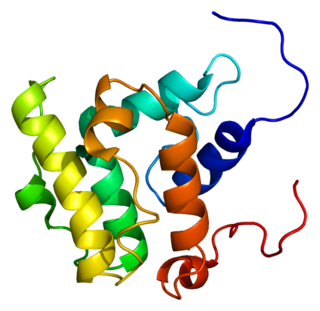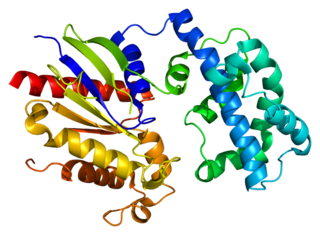GTPases are a large family of hydrolase enzymes that bind to the nucleotide guanosine triphosphate (GTP) and hydrolyze it to guanosine diphosphate (GDP). The GTP binding and hydrolysis takes place in the highly conserved P-loop "G domain", a protein domain common to many GTPases.

Ras homolog gene family, member B, also known as RHOB, is a protein which in humans is encoded by the RHOB gene.

Transforming protein RhoA, also known as Ras homolog family member A (RhoA), is a small GTPase protein in the Rho family of GTPases that in humans is encoded by the RHOA gene. While the effects of RhoA activity are not all well known, it is primarily associated with cytoskeleton regulation, mostly actin stress fibers formation and actomyosin contractility. It acts upon several effectors. Among them, ROCK1 and DIAPH1 are the best described. RhoA, and the other Rho GTPases, are part of a larger family of related proteins known as the Ras superfamily, a family of proteins involved in the regulation and timing of cell division. RhoA is one of the oldest Rho GTPases, with homologues present in the genomes since 1.5 billion years. As a consequence, RhoA is somehow involved in many cellular processes which emerged throughout evolution. RhoA specifically is regarded as a prominent regulatory factor in other functions such as the regulation of cytoskeletal dynamics, transcription, cell cycle progression and cell transformation.

Ras-related protein Rap-1A is a protein that in humans is encoded by the RAP1A gene.

Rho guanine nucleotide exchange factor TIAM1 is a protein that in humans is encoded by the TIAM1 gene.

cAMP-dependent protein kinase type II-alpha regulatory subunit is an enzyme that in humans is encoded by the PRKAR2A gene.

RhoGEF domain describes two distinct structural domains with guanine nucleotide exchange factor (GEF) activity to regulate small GTPases in the Rho family. Rho small GTPases are inactive when bound to GDP but active when bound to GTP; RhoGEF domains in proteins are able to promote GDP release and GTP binding to activate specific Rho family members, including RhoA, Rac1 and Cdc42.

Rho guanine nucleotide exchange factor 7 is a protein that in humans is encoded by the ARHGEF7 gene.

Rho guanine nucleotide exchange factor 6 is a protein that, in humans, is encoded by the ARHGEF6 gene.

Ras-related protein Rap-2a is a protein that in humans is encoded by the RAP2A gene. RAP2A is a member of the Ras-related protein family.

Rho guanine nucleotide exchange factor 1 is a protein that in humans is encoded by the ARHGEF1 gene. This protein is also called RhoGEF1 or p115-RhoGEF.

Rho guanine nucleotide exchange factor 11 is a protein that in humans is encoded by the ARHGEF11 gene. This protein is also called RhoGEF11 or PDZ-RhoGEF.

Rho guanine nucleotide exchange factor 12 is a protein that in humans is encoded by the ARHGEF12 gene. This protein is also called RhoGEF12 or Leukemia-associated Rho guanine nucleotide exchange factor (LARG).

RhoG is a small monomeric GTP-binding protein, and is an important component of many intracellular signalling pathways. It is a member of the Rac subfamily of the Rho family of small G proteins and is encoded by the gene RHOG.

The DBL proto-oncogene is a protein that in humans is encoded by the MCF2 gene.

Guanine nucleotide exchange factor VAV3 is a protein that in humans is encoded by the VAV3 gene.

Guanine nucleotide exchange factor DBS is a protein that in humans is encoded by the MCF2L gene.

Guanine nucleotide-binding protein subunit alpha-13 is a protein that in humans is encoded by the GNA13 gene.

Guanine nucleotide-binding protein subunit alpha-12 is a protein that in humans is encoded by the GNA12 gene.

Pleckstrin homology domain containing, family G member 2 (PLEKHG2) is a protein that in humans is encoded by the PLEKHG2 gene. It is sometimes written as ARHGEF42, FLJ00018.






















